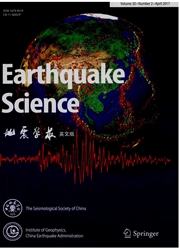

 中文摘要:
中文摘要:
The Gravity Recovery and Climate Experiment(GRACE) has been measuring temporal and spatial variations of mass redistribution within the Earth system since2002. As large earthquakes cause significant mass changes on and under the Earth’s surface,GRACE provides a new means from space to observe mass redistribution due to earthquake deformations. GRACE serves as a good complement to other earthquake measurements because of its extensive spatial coverage and being free from terrestrial restriction. During its over 10 years mission,GRACE has successfully detected seismic gravitational changes of several giant earthquakes,which include the 2004 Sumatra–Andaman earthquake,2010 Maule(Chile) earthquake,and 2011 Tohoku-Oki(Japan) earthquake. In this review,we describe by examples how to process GRACE timevariable gravity data to retrieve seismic signals,and summarize the results of recent studies that apply GRACE observations to detect co- and post-seismic signals and constrain fault slip models and viscous lithospheric structures. We also discuss major problems and give an outlook in this field of GRACE application.
 英文摘要:
英文摘要:
The Gravity Recovery and Climate Experiment(GRACE) has been measuring temporal and spatial variations of mass redistribution within the Earth system since2002. As large earthquakes cause significant mass changes on and under the Earth's surface,GRACE provides a new means from space to observe mass redistribution due to earthquake deformations. GRACE serves as a good complement to other earthquake measurements because of its extensive spatial coverage and being free from terrestrial restriction. During its over 10 years mission,GRACE has successfully detected seismic gravitational changes of several giant earthquakes,which include the 2004 Sumatra–Andaman earthquake,2010 Maule(Chile) earthquake,and 2011 Tohoku-Oki(Japan) earthquake. In this review,we describe by examples how to process GRACE timevariable gravity data to retrieve seismic signals,and summarize the results of recent studies that apply GRACE observations to detect co- and post-seismic signals and constrain fault slip models and viscous lithospheric structures. We also discuss major problems and give an outlook in this field of GRACE application.
 同期刊论文项目
同期刊论文项目
 同项目期刊论文
同项目期刊论文
 Direct regional quasi-geoid determination using EGM2008 and DEM: A case study for Mainland China and
Direct regional quasi-geoid determination using EGM2008 and DEM: A case study for Mainland China and Monthly GRACE detection of coseismic gravity change associated with 2011 Tohoku-Oki earthquake using
Monthly GRACE detection of coseismic gravity change associated with 2011 Tohoku-Oki earthquake using 期刊信息
期刊信息
